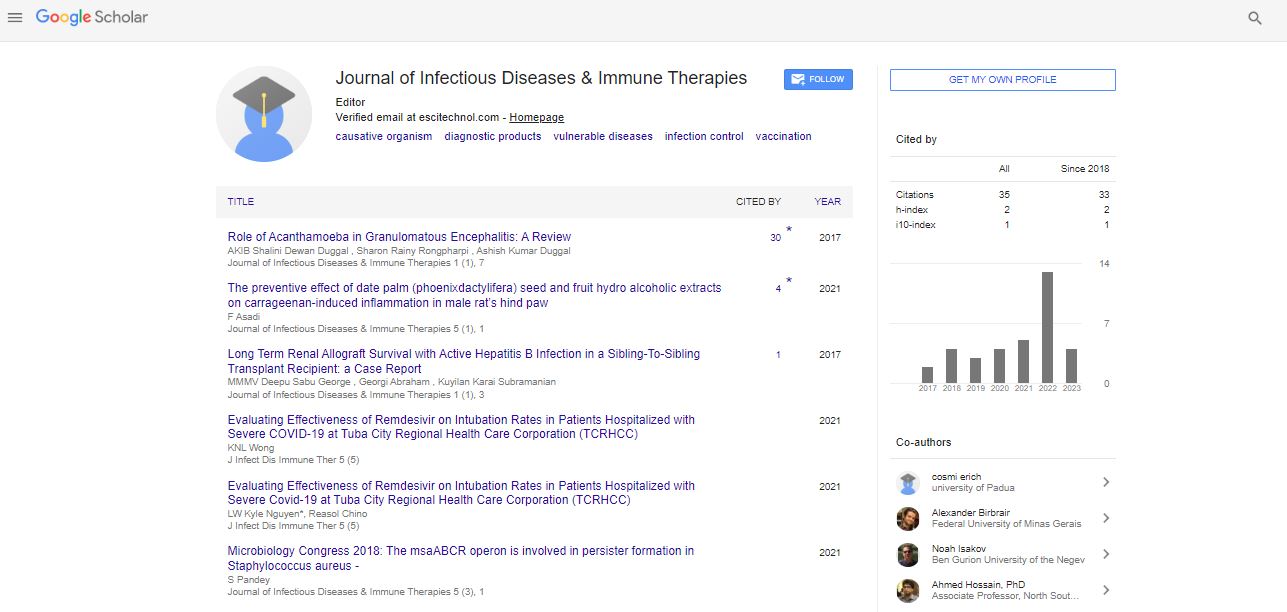Perspective, J Infect Dis Immune Ther Vol: 7 Issue: 1
Antimicrobial Resistance and the Threat of Bacterial Infections
Henao Dunham*
Department of Biology, College of Art and Sciences, Syracuse University, Syracuse, United States of America
*Corresponding Author: Henao Dunham
Department of Biology, College of Art
and Sciences, Syracuse University, Syracuse, United States of America
E-mail: henaham@syr.edu
Received date: 03 February, 2023, Manuscript No. JIDITH-23-93631;
Editor assigned date: 07 February, 2023, PreQC No. JIDITH-23-935631 (PQ);
Reviewed date: 21 February, 2023, QC No. JIDITH-23-935631;
Revised date: 28 February, 2023, Manuscript No. JIDITH-23-935631 (R);
Published date: 07 March, 2023, DOI: 10.4172/JIDITH.1000153
Citation: Dunham H (2023) Antimicrobial Resistance and the Threat of Bacterial Infections. J Infect Dis Immune Ther 7:1.
Description
Antimicrobial Resistance (AMR) is a growing worldwide public health threat. Bacterial infections that were once easily treatable with antibiotics are now becoming resistant to them, leading to longer hospital stays, increased healthcare costs, and higher mortality rates. The emergence and spread of AMR has become a significant public health challenge and it is essential to understand its causes and effects on bacterial infections.
The capacity of bacteria to resist the effects of antimicrobial drugs such as antibiotics is referred to as AMR. The misuse and overuse of antibiotics have led to the development of resistant bacteria. When antibiotics are used frequently or unnecessarily, bacteria can adapt and evolve, leading to resistance.
Causes of AMR
There are several causes of AMR. One of the main causes is the overuse and misuse of antibiotics. Antibiotics are often prescribed for viral infections or minor illnesses, where they are not effective, leading to the development of resistant bacteria. In addition, antibiotics are used extensively in agriculture, which contributes to the development of AMR in both animals and humans.
Effects of AMR on bacterial infections
AMR has significant effects on bacterial infections. It makes it more difficult to treat infections and can result in longer hospital stays, increased healthcare costs, and higher mortality rates. Infections that were once easily treated with antibiotics are becoming more difficult to manage and there are fewer options for treatment.
Prevention and control of AMR
Prevention and control of AMR require a comprehensive approach that involves all stakeholders.
This approach includes the following measures:
Rational use of antibiotics: The rational use of antibiotics involves using antibiotics only when they are necessary, using the right antibiotic for the right infection, and using them for the correct duration.
Infection prevention and control: Effective infection prevention and control measures can reduce the need for antibiotics and prevent the spread of resistant bacteria. Measures such as hand hygiene, isolation, and the use of personal protective equipment can be effective in preventing the spread of infections.
Vaccination: Vaccines can prevent bacterial infections and reduce the need for antibiotics. Vaccines are an effective way to prevent infections and reduce the risk of developing antibiotic-resistant bacteria.
Surveillance and monitoring: Surveillance and monitoring of AMR can help to identify trends and patterns of resistance, allowing for early intervention and management of resistance.
Education and awareness: Education and awareness campaigns can help to promote responsible use of antibiotics, increase awareness of the dangers of AMR, and encourage the public to take action to prevent its spread.
Conclusion
Antimicrobial Resistance (AMR) is a major worldwide public health threat. The overuse and misuse of antibiotics have led to the development of resistant bacteria, making bacterial infections more difficult to treat. Prevention and control of AMR require a comprehensive approach that involves all stakeholders. By promoting responsible use of antibiotics, implementing effective infection prevention and control measures, and increasing awareness and education, we can reduce the spread of AMR and protect public health.
 Spanish
Spanish  Chinese
Chinese  Russian
Russian  German
German  French
French  Japanese
Japanese  Portuguese
Portuguese  Hindi
Hindi 